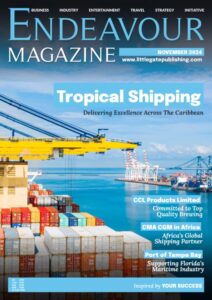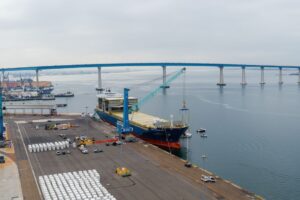The Republic of Guinea in Western Africa is home to vital bauxite, gold, diamond, and iron ore deposits, with the mining industry playing a key role in the development of Guinea’s economy. To date, only bauxite and gold have been industrially mined, but with such a wealth of iron ore at the country’s disposal, Rio Tinto SimFer are developing a high-grade iron ore project in the Simandou Mountain range in the southeast of Guinea. The iron ore project aims to deliver a significant source of high-grade iron ore that will strengthen Guinea’s role in the global economy, whilst delivering vital community development.
Check out the article in the magazine below:
Rio Tinto SimFer, is a joint venture held between the Government of Guinea and Chalco Iron Ore Holding (CIOH), of which Rio Tinto is the majority shareholder. Simandou is divided into 4 blocks, with Rio Tinto SimFer holding blocks 3 and 4, which are estimated to contain 1.5 billion tonnes of iron ore reserves. Across blocks 1 and 2, Rio Tinto works alongside the Government of Guinea and the Winning Consortium Simandou (WCS) developers of Simandou, to help develop the infrastructure to export mined iron ore from the southeast of the country and towards the country’s ports. Across the 4 blocks, the project has vast challenges, not only due to the terrain but with the project being located 600kilometres (km) from the country’s coastline for export, Rio Tinto SimFer has set out a unique approach where multiple investors and industrial mining companies will come together with the Government of Guinea in a world-first partnership project.
The SimFer Mine is located across blocks 3 and 4 of the Simandou Project, and contains two main deposits, Ouéléba and Pic de Fon, as part of the mining concession. These deposits are between 6 and 8 km long, 1-15km wide, and 500m deep. The Ouéléba deposit to the north of the development has the largest surface area, containing around 1.5 billion tonnes of high-grade ore reserves. Rio Tinto SimFer plans to deliver the Ouéléba deposit as an open-pit mine utilising drilling and blasting rock techniques. Ore from the mine will then be hauled into trucks and moved to primary and secondary crushers. Conveyor systems are then planned to transport the crushed ore down the mountain from the mine for additional crushing, and then through transport infrastructure towards the country’s port. Construction of the mine is well underway, as roads to the mine and the mine’s infrastructure, including the installation of a water supply and fuel storage, are being completed.
The second deposit, Pic de Fon, is still being assessed for development; however, the first production from the Ouéléba orebody is expected by the end of 2025. After production commences, the mine will continue to ramp up over 30 months to reach the expected annual capacity of 60 million tonnes per year. The mine complex is expected to deliver 26 years of mine life, with further exploration planned over the next 5 years to explore new areas of potential mineralisation that could be mined in the future.
Once iron ore from Simandou is mined, it is then transported via the main Trans-Guinean rail line to deliver the ore to the port, where it can be loaded onto a transhipment vessel for international markets. However, this delivery of the ore is one of the largest challenges Rio Tinto will face, as currently, at least 600km of the coastline in Guinea has no existing rail line or port facilities to help transport ore to customers. Therefore, Rio Tinto will work on delivering a new rail and port infrastructure to help support the delivery of ore to market. This infrastructural development will span blocks 1 and 2 of Simandou, where Rio Tinto will work with the Government of Guinea and Winning Consortium Simandou (WCS) to deliver this. A significant development of this is the establishment of La Compagnie du TransGuinéen (CTG), which is held in an equity share between Rio Tinto SimFer (42.5%), WCS (42.5%), and the Government of the Republic of Guinea, who hold a 15% free equity stake. Thus, CTG will be jointly funded by Rio Tinto SimFer and WCS, in partnership with the Government of Guinea, to deliver the vital rail and transportation infrastructure needed to deliver the high-grade ore from the mine to market.
Across the entire Simandou project under Rio Tinto SimFer, there remains a key focus on ensuring that its mine and associated infrastructure positively impact the local communities of Guinea, delivering the project as a lasting source of development for current and future generations. By 2030, the entire Simandou project is projected to increase the country’s Gross Domestic Product (GDP) by 26-55%, which will be achieved through the taxes and royalties from the project, alongside its indirect employment, and transport infrastructure that will benefit the country across multiple sectors, not just for the mining project.
Another key benefit the Simandou project will help deliver is an increase in the amount of international investment into Guinea, thanks to the stable supply of raw materials that the mining development will produce for the local and global economy. One of the key reasons for this is due to iron being a key metal for the future, especially for its role in steelmaking. Iron is used to galvanise steel, which is one of the leading metals pioneering the push towards future development, being utilised in every industry from manufacturing to sustainable energy development. Thus, by delivering such high-grade iron ore to market, the Rio Tinto SimFer project aims to help promote the role of Guinea in the global iron industry and cement its role as a key iron producer primed for further investment.
Over the coming years, Rio Tinto SimFer will deliver the rail spur and main rail line for the country, allowing shipping through the WCS barge port until the SimFer Transhipment vessel port is completed. By 2028, the SimFer mine is projected to reach 60Mpta and, in the process, deliver significant social and economic benefits for the region.
Ultimately, the Simandou project conducted by Rio Tinto SimFer is an exciting development for the iron industry, and especially for the Republic of Guinea, as the mine and its associated rail and port infrastructure are set to deliver significant benefits to solidify Guinea’s place as a hub primed for investment spanning across the mining and infrastructural development sector. With a challenging but vital project set to commence production very soon, we look forward to seeing how Rio Tinto SimFer will shape the future of the iron ore industry and, in the process, deliver Guinea as a leading iron-producing country that supports its people and the country’s local development.








